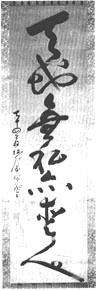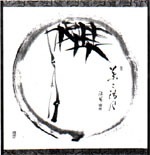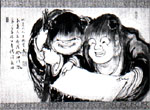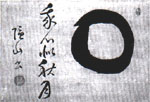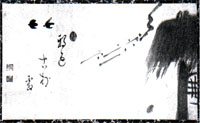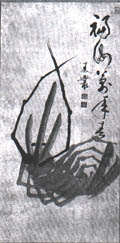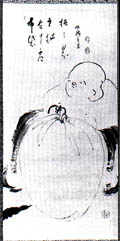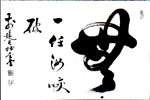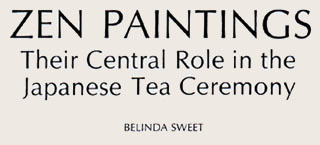
CHANOYU,
as the tea ceremony is called in Japan, is a meditative ritual involving a
group of participants and a gathering of objects, the ultimate purpose of
which is to reveal the profound sacredness at the foundation of the everyday
acts of our lives: of eating, drinking, moving and interacting with people
and objects. It is a lesson in
the art of living fully and deeply, experiencing and gratefully appreciating
the everyday miracles of existence.
Most
people have their first encounter with the tea ceremony through a public
demonstration of that part of the ritual in which a bowl of tea is made.
Isolating this single aspect from the whole has had the unfortunate
result of giving the false impression that chanoyu is cold and stiff.
In fact, the full tea ritual, of chaji, is three or four hours
in length, and involves the host and his or her assistant, five guests and
several helpers in the kitchen. Before
the tea is made, charcoal for the fire to boil the water is laid in front of
the guests and a meal of seven courses is served, including generous
pourings of sakč. If the chaji
takes place during the night or early morning hours it is done by
candlelight. There is talk,
conviviality and laughter. Yet everyone involved is also aware of the responsibility of
fulfilling their prescribed roles in a way that smoothly and unobtrusively
contributes to the success of the event and the good of the whole.
Through the experience each participant’s body, mind, heart and
spirit are being nourished.
The
guiding principles of chanoyu are Wa, Kei, Sei, Kaku (Harmony,
Respect, Purity and Tranquility). It is believed that if the first three are
present, then tranquility will follow naturally.
An expression, which is also often used, is Ichigo Ichie (One
time, one meeting). It serves as a reminder not only during the tea ceremony
but in our daily lives to stay awake and aware of each moment in time, which
is unique, precious and unrepeatable. In Japan, an entire culture has
evolved to support and enhance this ritual. Tea has become the embodiment of
the arts of traditional architecture, gardens, ceramics, lacquer, baskets,
metalwork, kaiseki cooking and Zen painting and calligraphy.
It
is the duty and pleasure of the host in planning the event to give great
thought to providing the best and most inspiring experience for the guests.
The objects the host elects to use will together weave a story and evoke a
feeling that will slowly be revealed during the course of the chaji. There
will always be a seasonal reference. The story is told in part through the
seasonal appropriateness of the food and objects themselves, but mainly
through the words of the scroll and the poetic names, which have been given
to some of the utensils. These names and the history of the objects are
discussed as a vital component of the ritual. The objects are customarily
named not by the host, but by a Zen teacher or tea-master who has carefully
and intuitively studied the object and given it a poetic name that emphasizes
the subtle qualities the object evokes.
These names are written on the wooden boxes in which the objects are
stored.
The
utensils are also chosen with a strong regard for the way they harmonize and
interact with each other. This
harmony does not mean blandness of any sort, however, and often includes
somewhat startling and unexpected contrasts designed to underscore and
enhance the unique beauty of each object.
For example, among ceramics of an elemental and rustic taste will be,
perhaps, a gilded porcelain utensil of refined decoration.
Of
all the objects that will be brought together in the performance of a tea
ceremony, the scroll that is the writing of a Zen priest is unequivocally
the most important. It is the
first thing seen upon entering the tearoom and the only object that is honored
with a bow. The words
of the scroll will set the theme of the tea, but more importantly, it is
thought that through the medium of the ink on paper and the intentionality of the priest at the time it was brushed, the character and spiritual power
of the writer is present in some way as the guiding influence of the tea
event. In Japanese, the
writings of Zen priests are called bokuseki, or "ink traces" in English.
The bow is meant to show respect for the writer of the scroll and the
spiritual meaning of the words.
Ceremonial
tea drinking and Zen practice have been intertwined since they were brought
together to Japan from China at the end of the twelfth century.
But chanoyu did not come into its full flower until the sixteenth
century, under its great patriarch Senno Rikyu (1522- 1591).
He was a man of aesthetic genius and the arbiter of taste in his
time. His creativity and
discrimination form the foundation of tea as it is practiced today, as well
as what is thought of as uniquely Japanese taste.
Among his accomplishments are the development of raku pottery and
kaiseki cuisine.
Rikyu
was born into the merchant class, became a tea-master who served in this
capacity under the military ruler of Japan, Oda Nobunaga (1534-1582) and
achieved fame as tea-master to his successor Toyotomi Hideyoshi (1537-1598).
He studied with two important tea-masters of his day, Kitamura Dojin
(1504-1562) and Takeno Joo (1502-1555) and was greatly influenced in the
development of his taste by the earlier figure, Murata Shuko (died 1502).
Zen calligraphy was first used in the tea ceremony by Shuko.
His Zen teacher, the legendary Ikkyu Sojun (1394-1481) presented
him with a treasured scroll of the calligraphy of the Chinese priest Engo
Kokugon (1063-1135) as an acknowledgement of Shuko's enlightenment.
This began the custom of hanging the writing of a Zen priest at the
tea ceremony.
Rikyu
pursued his own study of Zen at Daitokuji Temple in Kyoto with Kokei Sochin
(1532-1597), with whom he had a long and close friendship.
Although Rikyu owned many ancient treasures, including the Engo
calligraphy which he often used in his tea gatherings, he also began the
until then unprecedented custom of using the calligraphy of a living Zen
priest by hanging the writing of his friend and teacher Kokei.
In
addition to the main scroll in the tearoom, which is most often calligraphy,
another scroll will be presented in the waiting area where the guests gather
prior to entering the tearoom together.
This scroll will be of a less serious nature, and will often be a
painting.
It
will always have some relationship to the primary scroll, and help in
developing the theme. In tea
taste, repetition of anything is strongly avoided but things are chosen for
their subtle cross-references.
Because
of the importance of acknowledging the changing seasons in chanoyu, the
first eight scrolls were chosen to illustrate what would be appropriate
paired scrolls for tea ceremonies held in spring, summer, fall and winter.
All of the scrolls shown in this article were brushed by Japanese Zen
priests. The translations are
by John Stevens, with the exception of the seventh scroll, which is by
Stephen Addiss.
|
|
The
first scroll* by Rozan Eko (1865-1944) is appropriate for spring in the
waiting area as the gourd shape is a reminder of the hollow dried gourds
used as traditional sake containers which were taken on cherry blossom
viewing picnics as part of the celebration of the coming of spring.
The words say: A fragrant wind, flowers, and the moon |
|
Although
the shape of the gourd is abstract enough to almost be considered
calligraphic, the writing is still enclosed in a painting.
The principal scroll* to be used on this occasion, by Banryu
(1848-1935), says: Once again Heaven and Earth While both scrolls refer to spring they do so in different ways. Also, the artist of the first scroll is younger than the writer of the principal one.
|
|
|
|
In
summer it is important to evoke a cool feeling as a counter to the heat in
consideration of the guests. In
the waiting room scroll* by Deiryu (1895-1954) we already begin to have this
feeling just looking at the painting of the bamboo which seems to be
slightly in motion given the angle of the leaves and stems.
This is developed further with the words inscribed: A pure breeze rustles the leaves |
|
The
following scroll* by Kaimon Zentaku (1743- Flowing
waters by Cold Mountain Road |
|
Both
scrolls evoke a feeling of coolness through movement, but through different
elements of air and water. This
scroll also contains a subtle reference to the coming fall with the words
"Cold Mountain Road". The
best time for moon viewing is the fall, and the Chinese poet Kanzan, who
lived on "Cold Mountain", is associated with the moon, as we will
see in the following two selections for fall.
|
|
The waiting-room scroll* chosen for this fall moon viewing tea ceremony to be held at night is a painting of the two Zen figures of Kanzan and his friend Jittoku. They lived in China in the ninth century. Kanzan was a hermit poet whose poetry is highly regarded by Zen practitioners. Jittoku was the kitchen helper in a nearby monastery. He is often shown as here, holding a broom. Kanzan, the poet, is holding a scroll on which nothing is written, and the two are shown laughing as usual. |
Chingyu Zuiko (17431822) inscribes this painting:
Masters Kanzan
and
Jittoku
Always in perfect accord
Sporting together in high spirits
|
|
Inside
the tearoom is this Enso (Zen circle)* by Inzan len (1754-1817).
In recognition of the fall moon viewing this is an exception to the
usual practice of hanging only a scroll of calligraphy in the tearoom
itself. The words are part of
the most famous poem of Kanzan: My heart is like the Autumn Moon |
|
Winter
is part of the natural cycle which includes a time of dormancy, rest and
renewal. Sometimes this may
seem to be a period of trial and difficulty, as though nothing we do can
effect change. The harbinger of
this time is evoked by this painting* by Reigen Eto (1721-1785): Crows pass |
|
|
|
The
calligraphy* by Hakuin Ekaku (1685-1768) chosen for this season reminds us
that in times that may seem difficult and as though they may never end, we
should know that we arc not alone. We
can call on the great bodhisattva of compassion, Kannon. ALWAYS IN MIND Through
this cycle of tile seasons, so important in tea, we are reminded of the
paradox of constant change within continuity.
The seasons are constantly changing, yet they are always returning. |
In
addition to the very basic and profound use of the seasons as a solid place
that tea returns to again and again, there are other cultural events that
call for chanoyu. The New Year
celebration is very important in the world of tea.
When Japan was still using the Chinese calendar new years came in
February, which seems a very appropriate ending to winter.
The following two scrolls could be used for this occasion.
New Year is a time of congratulation and good wishes.
|
This
painting of a shrimp* by Shunso joshu (1750-1839) was probably painted in honor
of the New Year, and might be hung in the waiting area. An Ocean of Good
Fortune Because
of the bent back of the shrimp it is considered a symbol of old age and long
life. So in addition to the
words, the painting itself represents good wishes. The
Oriental Zodiac has twelve animals: the rat, ox, tiger, rabbit, dragon,
snake, horse, sheep, monkey, rooster, dog and boar.
Each year is presided over by one of these animals, which changes at
the New Year. |
|
|
|
The
next scroll* is calligraphy that reads "ox" in the abstract shape
of an ox. This scroll might be
a little too playful for use in the tearoom itself on any other occasion
than a New Year that begins the year of the ox. |
|
|
The
last four scrolls could be used on numerous occasions and in any season, the
first two* being appropriate for the waiting area.
The exceptionally large painting of Hotei by Mamiya Eishu (1871-1945)
reads: Hotei begs in the vast Universe The
calligraphy on the painting of Daruma, the founder of Zen in China, by
Kakugan (1793-1857) says: Spring rain opens the flowers |
|
|
|
The
last two calligraphic scrolls could be used in the tearoom itself during any
season. The scroll* by Setsudo
Genko (?- 1852) has a particularly direct Zen theme: EMPTINESS |
|
This
last gentle calligraphy* done in his old age by the great Zen master Hakuin
Ekaku (1685-1768) that follows is particularly interesting as the saying is
one of the Jodo sect of Buddhism, and not of the Zen sect. It illustrates his character very well, in that although he
was known to be very strict in Zen studies with his disciples, he would
often brush the sayings of other sects for their believers. Taking refuge in Amida Buddha |
|
|
|
Hakuin Ekaku |
||
Chanoyu has been used in the service of many causes throughout its history. Shoguns have used it to solidify their power and reward vassals; hosts have used it to impress others with their wealth, taste and sophistication; and young ladies of marriageable age have been taught proper deportment through it. However, no matter what is happening on the surface of a tea event, deep philosophical truths are being expressed through the scrolls and the physical movements of the ritual. Perhaps this was best said by Rikyu himself. Chanoyu of the small tearoom is first of all a Buddhist spiritual practice for attaining the way.

